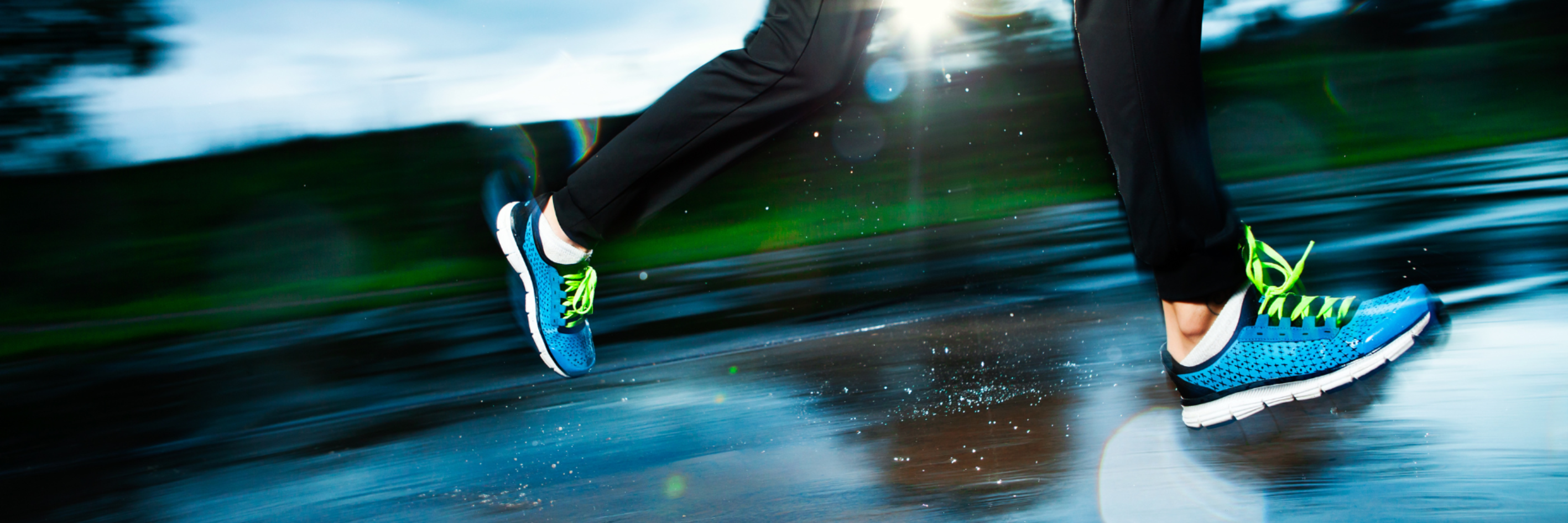In our latest application insight, we’re focusing on Dry Rate Testing.
What’s covered:
- An introduction to drying rate
- Performance textiles and the human body
- The role of 'comfort'
- Features and functions
- Base layer performance testing
- Test methods
- Dry rate testing using ProDry
An introduction to drying rate
Having our performance clothing and footwear dry out efficiently is considered to be a key feature for most performance garments, as nearly every item that we wear will come into contact with liquid moisture from one point of origin or another, be it from snow, from rain, or most commonly of all from sweat.
To give some context, a common misconception in this area of textiles is that cotton fibre wicks well, and acts as an efficient textile for sporting activities. Whilst cotton does provide softness and often warmth, it does not wick efficiently, and it does not dry out easily either, as the fibre itself is highly absorbent.
For effective drying and wicking, we want less porous fibres, and ideally we want continuous filament extruded polymer yarns such as polyester, or other synthetics which have a low to zero percent absorption rate.
With this type of testing, there is a lot of emphasis on the term rate, but what is the importance in knowing the rate in which a textile or garment dries?
Some key terminology surrounding dry rate testing is:
- Drying rate — the change in volume per unit time a liquid evaporates from a textile.
- Drying time — the time it takes for a specified amount of liquid to evaporate from a textile under controlled testing conditions.
It is the rate and time in which a textile dries that forms the basis of the results when testing a textiles drying capabilities.
It’s fair to state that dry rate testing, whilst is a stand alone test, is one of various methods used to assess the moisture management of a material which needs to be measured. It is usually considered holistically before making any final material selection for upcoming products.

Lisa Keeling, Technical Specialist"The better the garment is at sweat-wicking and drying, the more stable the body's surface temperature".
Performance textiles and the human body
To further understand the functions of performance garments, and to explore why dry rate testing is such an important subject in this area of textiles, we need to look closely at the relationship between performance textiles and the human body.
The importance of maintaining a constant body temperature
The human body is constantly generating heat and tries to regulate its core temperature between 36.5 – 37.5°C . To cool down, the body sweats which then evaporates from the skin, taking heat away and therefore cools our body.
Efficient drying in our performance textiles relates closely to our health. The better the garment is at sweat-wicking and drying, the more stable the body's surface temperature. Effective thermoregulation here provides both comfort and safety, as our garments and footwear can dry out before the liquid moisture has time to drop in temperature and cause what is known as post exercise chill sensation.
Overheating can also be a concern much like the drop in temperature can, and these extreme changes in temperature can sometimes be dangerous, for example high temperatures can cause dehydration and heatstroke, and can also impact how we feel wearing clothing
The role of 'comfort'
One important purpose of performance textiles and clothing is to enable the wearer to be comfortable throughout a range of different activities, in a variety of different climates.
Lisa Keeling, Technical Specialist"Comfort is a key feature of performance textiles. As well as looking good, it’s important for wearers to feel comfortable in their performance garments during a range of different activities."
Thermal comfort can be defined by the absence of any unpleasant sensations of being too cool or too warm, or of having too much perspiration on the skin, but it isn’t the only factor in determining overall comfort.
Other factors which may influence a wearer’s perceived ‘comfort’ include the fit of a garment, known as 'fit factors'. Fabric properties such as stretch and recovery, as well as the thermal and moisture management properties also play a vital role, as well as of course a garment or textiles ability to dry-off quickly and efficiently.
It is more than just garments that require a level of 'comfort'.
Comfort isn’t just about the clothing we wear, but about the textiles that are all around us, such as home furnishings like where we are sitting at home and at work, it also includes bedding and mattresses of which we spend a huge portion of our lives when we sleep.
When thinking about the impact that comfort has in terms of sleeping well and being able to work comfortably, it is a highly important feature for consumers to have, and especially when there is such a high volume on the market with many having significant price tags attached.
The feeling of being uncomfortable, particularly when relating to temperature and thermo-regulation, can apply anywhere that the skin is exposed to a fabric, so testing for the drying rate of a textile exposed to the skin helps to build a picture of the moisture management properties, and ultimately the comfort factors of our performance textiles.

Features and functions
Performance textiles and clothing need to have a range of different functions to meet the wearer’s needs and expectations, and the overarching benefit of performance textiles is that they offer additional functionality beyond what is expected of typical fabrics. These pieces are often an investment for the wearer and so the expectations are higher – they want functions beyond the typical characteristics such as colour fastness and abrasion resistance, for example.
In a bid to better understand consumers, research from the Cotton Incorporated Lifestyle Monitor Survey found that 50% of people would pay a premium for water repellent apparel, 48% for thermal regulating and 46% for moisture management.
In this survey, 58% of shoppers said the term ‘keeps you dry’ would be the most influential in their decision to buy a moisture wicking shirt. Therefore, retailers and brands are spending a lot of time researching on how to improve the fabrics so that they can perform these functions.
Lisa Keeling, Technical Specialist“Being able to prove key terms can make the difference between a consumer buying an item and not.”
Many different properties need to combine to make a performance fabric and can be used in various combinations to suit the activity and the environment.
For example, a garment worn during high intensity, indoor activity such as a spin class in the gym would need to be:
- Moisture wicking
- Quick drying, and;
- Odour control functionality
Whereas a garment intended for outdoor, cold weather activity such as skiing or hiking will need to be:
- Wind resistant
- Water resistant
- Thermally insulated

Base layer performance testing
Commonly referred to as the “second skin”, the base layer is worn directly next to the skin or under garments, and should effectively manage liquid moisture from perspiration. The main function of this layer is to effectively manage moisture and should promote rapid and wide distribution of liquid perspiration to allow it to evaporate.
Testing for moisture management properties include two main types: tests for absorption/distribution of liquid moisture within a fabric; and tests for rate of drying - i.e. an evaporation of liquid moisture from a fabric.
Testing base layer garments includes:
- Wicking (moisture management)
- Drying rate (moisture management)
- Stretch and recovery
- Odour control
- UV protection
Starting with the base layer, there are a number of different properties and different ways these can all be tested. Moisture management and wicking properties can be tested by a number of standard methods which are mainly AATCC methods and these aim to measure the ability of the fabric to transport moisture through its structure.
Several AATCC methods for drying rate also exist, which all involve timing how long a wetted fabric takes to dry by a number of different drying methods (such as heated plate).
Additional testing such as odour control verification is usually done by antibacterial testing and the UV protection testing measures the amount of light blocked from passing through a fabric. This can be an important feature for any hot weather garments or swimwear.
There is a technical document from the CEN 'CEN/TR 16422:2012 Classification of thermoregulatory properties' which provides guidance on what combination of properties are required for differing activities, in accordance with the classification of the thermoregulatory properties in certain textiles.

Test methods
There are several methods for dry rate testing including the AATCC 201 heated plate method as this is applicable to all types of fabrics, including knits, woven, and nonwovens.
Tests for drying/evaporation:
- AATCC 199 Drying rate of textiles: Moisture analyser method
- AATCC 200 Drying rate of textiles at their absorbent capacity: air flow method
- AATCC 201 Drying rate of fabric: Heated plate method
There are 3 main methods of AATCC tests for drying rate, and whichever you use is dependent on fabric type and by what is stated in the standard that you are using.
The 201 method especially determines the drying rate of a fabric based on the evaporative rate that occurs when the fabric comes into contact with a predetermined amount of water on top of a heated metal plate, which is held at a constant temperature set at 37°C. This is the core skin surface temperature at which the human body starts to perspire.
The aim of this test is to provide a consistent view of how long it takes for a fabric to dry. Main points include:
- The start time is when the water is added to the specimen.
- The test method requires the steepest slope as the material begins to dry to be measured over 7 points, and the flat section is measured over 25 points as pre-set in the standard.
- The end time is the time at the intersection between the steepest slope and the flat section of the temperature plot when the specimen being tested returns to a temperature of 37 degrees.

Dry rate testing using ProDry
Start by stabilising the test area
To begin the test, you must first allow the heated plate to let the testing area stabilise to 37 °c (body temperature) which is measured by the infrared temperature sensor

Equilibrate the specimen
You then place your test specimen on the metal plate for five minutes to allow the specimen to equilibrate to the metal plate temperature, as it would when in contact with the human body.

When the water is dosed, the data recording starts
After 5 minutes of the specimen being equilibrated on the metal plate test area, the water will then be dosed to the middle of the specimen and the recording of data starts, with an instant curvature (temperature drop) appearing on the graph.

Your end calculation is:
R (drying rate, in mL/h V ) = V (volume of water used in the test, in mL) / Drying Time (End time – Start Time, in hours)
Expert tip:
The Infrared probe must be lined up with the centre of the specimen
to accurately record the temperature throughout the test.
- Accuracy is paramount
- Important not to impede airflow
- Anemometer does not obstruct access to sample
- Looking for consistent laminar flow across heated plate
- Air flow inconsistencies can impact the dry rate result
Test instruments use a hot wire anemometer to verify that the air flow across the plate is 1.5 +/- 0.5 m/s across the entire width of the hot plate.
Regulating air flow is important to maintain consistency from test to test. With any test you perform in a lab, you must ensure the same conditions are present to accurately reproduce tests regardless of whether the test takes place hours or days later. For this reason it is always recommended that any testing is carried out in a conditioned lab.
Furthermore, there were some modifications to ProDry to reduce interference being recorded in the results, including mounting the anemometer behind the IR probe, allowing the air flow to be recorded before it passes through any obstructions which may displace the air flow.
Adding in additional fans creates a more consistent laminar flow through the instrument internally. If the air flow was not laminar you would see the smoke twisting in a spiralling motion, creating turbulence in the chamber which may affect the reading.
Water dosing: manual or automatic?
There is an argument for automated dosing as technicians look for ways to reduce variability between tests. Automation in almost all areas of testing seems to be a growing requirement to remove any risk of deviation from test to test and additionally from technician to technician.
“With ProDry, the added ability to automate water dosing removes the need to manually apply the water to the underside of the fabric specimen using a water reservoir on the side of the instrument”, says Lisa. “This applies the water to the underside of the specimen without needing to lift the sample and (if mounted correctly) you’re guaranteed to dose the centre of the specimen every time. It also automatically records the start of the test removing any need for manual input or recording of data.”
Most testers such as ProDry can also be operated manually, and this can be important for enabling users to perform specific tests with a varying liquid dose. Whilst this can be a benefit to certain labs, we would always recommend that an automated micropipette is used here to maintain consistency and accuracy, reducing any potential variables between tests.
Enjoyed this article?
We'll be sharing more testing insights and application articles on our 'News & Insights' page - check out our social media and website for updates.
For related content, see...Applications Insight: The Fundamentals of Wicking
Contact us today
Get support from the textiles testing experts and talk to us about your testing requirements.












